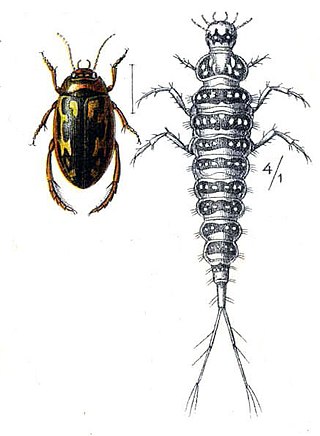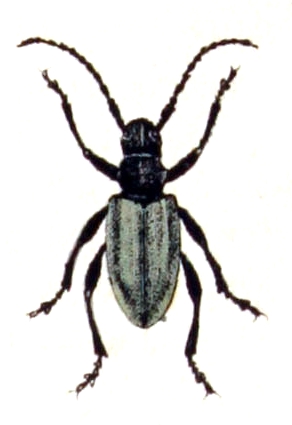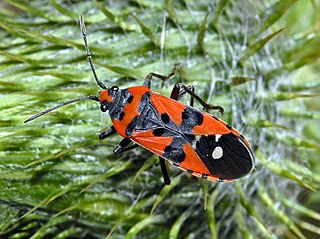
Pentatomidae is a family of insects belonging to the order Hemiptera, generally called shield bugs or stink bugs. Pentatomidae is the largest family in the superfamily Pentatomoidea, and contains around 900 genera and over 4700 species. As hemipterans, the pentatomids have piercing sucking mouthparts, and most are phytophagous, including several species which are severe pests on agricultural crops. However, some species, particularly in the subfamily Asopinae, are predatory and may be considered beneficial.

Colymbetes is a genus of beetles native to the Palearctic, including Europe, the Nearctic, the Near East and North Africa.

Hygrotus is a genus of beetle in family Dytiscidae. It contains two subgenera and about 70 species, including:

Cymindis is a genus of ground beetle native to the Palearctic, the Near East, and North Africa. It contains the following species:

Platambus is a genus of beetle native to the Palearctic, including Europe, the Near East and North Africa. It distinguished by a wide epipleuron. The ventral surface has spot markings.

Sphenoptera is a genus of beetles in the family Buprestidae, containing the following species:
Cymindis cordicollis is a species of ground beetle in the subfamily Harpalinae. It was described by V. E. Jakolev in 1887.

Chlorion is a genus of Hymenoptera of the Sphecidae family of wasps.

Polistes semenowi is a species of paper wasp in the genus Polistes that is found in southeastern and southern central Europe, as well as central Asia, and was until 2017 erroneously known by the name Polistes sulcifer, while a different species was incorrectly believed to represent P. semenowi. It is one of only four known Polistes obligate social parasites, sometimes referred to as "cuckoo paper wasps", and its host is the congeneric species Polistes dominula. As an obligate social parasite, this species has lost the ability to build nests, and relies on the host workers to raise its brood. P. semenowi females use brute force, followed by chemical mimicry in order to successfully usurp a host nest and take over as the queen.

Dorcadion is a genus of longhorn beetles of the subfamily Lamiinae.

Eodorcadion is a genus of longhorn beetles of the subfamily Lamiinae, containing the following species:
Eocarterus semenowi is a species of ground beetle in the genus Eocarterus.
Dorcadion tibiale is a species of beetle in the family Cerambycidae. It was described by Jakovlev in 1890. It is known from China and Central Asia.
Dorcadion jacobsoni is a species of beetle in the family Cerambycidae. It was described by Jakovlev in 1899. It is known from China and Kazakhstan.
Eodorcadion maurum is a species of beetle in the family Cerambycidae. It was described by Jakovlev in 1890. It is known from Mongolia.
Eodorcadion intermedium is a species of beetle in the family Cerambycidae. It was described by Jakovlev in 1890. It is known from Mongolia.

Lygaeus is a genus of seed bugs in the family Lygaeidae. There are more than 60 described species in Lygaeus.

Scolopostethus is a genus of dirt-colored seed bugs in the family Rhyparochromidae. There are more than 30 described species in Scolopostethus.

Emblethis is a genus of dirt-colored seed bugs in the family Rhyparochromidae. There are more than 30 described species in Emblethis.

Enoplops is a genus of Palaearctic bugs, in the family Coreidae and tribe Coreini. Species are recorded from Europe and includes E. scapha found in the British Isles; there are also records from North Africa and China.













